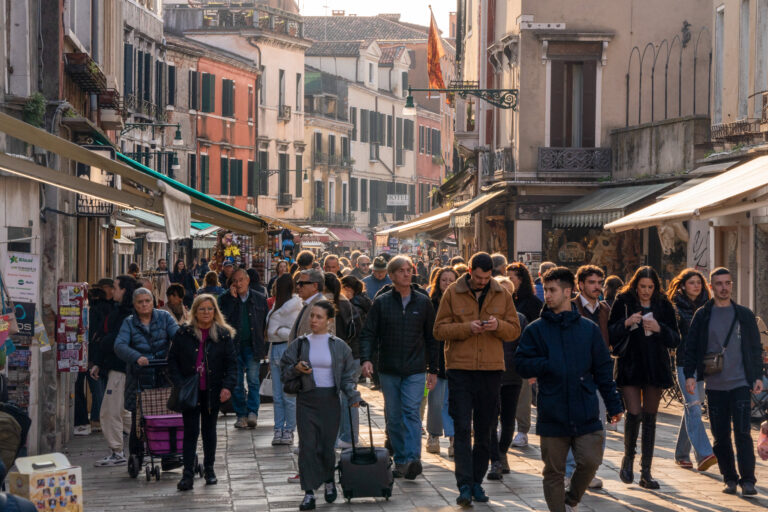He considers himself lucky to be a boat driver and pities the poor tourists who have to rent a car or find an elusive taxi.
“Some days it takes an hour to go 10 kilometers. [about 6 miles]”In many towns traffic can only go one way, so everyone has to wait,” he said.
I can’t live with them or without them
Italy is caught in an enviable trap: it cannot survive without tourists, yet it is struggling to cope with the influx, especially since the COVID-19 pandemic. 60 million tourists flocked to Italy last year, pumping huge amounts of money into the economy. According to Statista, the share of travel and tourism in Italy’s GDP in 2022 will be 10.2%. The sector employs around 4.4 million people, about 16% of total employment.
A general view of the Pantheon’s facade in Piazza della Rotonda in Rome, Italy on March 30, 2024.
Emanuele Cremaschi | Getty Images
“Too many tourists” may seem like a problem the country wants to have, but in recent years tourist crowds have become so bad that Italian authorities have been forced to take measures to prevent damage to centuries-old monuments that cannot withstand the crowds. Venice, for example, now charges day-trippers who don’t stay the night a 5 euro entrance fee to the city.
Want to see Da Vinci’s “The Last Supper” in Milan? You’re in luck. Tickets sell out weeks in advance, and only about 30 people are allowed inside at a time for a maximum of 15 minutes to avoid irreparable damage to the painting.
Not only are there too many tourists, but there are also not enough people to serve them.
The Italian Association of Employment Agencies (Asolavoro) said there was a shortage of staff in the hotel and beach sectors this summer with tourist numbers expected to hit a record high. The Marche region is short of chefs and waiters, while Sardinia needs around 25,000 seasonal workers.
Is Italy a bargain? Not really, but it’s well worth it
Food is surprisingly affordable, at least compared to New York prices: In Milan, an hour away, you can get an espresso for 1 euro (about $1.10) and a croissant for 2 to 3 euros.
At the famous Trattoria Milanese in central Milan, you can get generous servings of two of the city’s most famous dishes, veal Milanese and osso bucco with risotto Milanese, for around $30-35 per plate, with lesser-known establishments offering cheaper options. Excellent local wines can be purchased for $20-30 in restaurants and $10 in supermarkets.
Even Milan’s famous bars aren’t that pricey: At Camparino in the Galleria, one of Italy’s temples of cocktail culture, you can get a Negroni or Aperol Spritz for $20, served by a ridiculously good-looking 25-year-old waiter in formalwear to the super-dressed crowd milling about through the night to catch an opera at La Scala.
With the influx of tourists, it’s hard to get a reservation: here on Lake Como, it’s still nearly impossible to get a reservation at the Veranda Restaurant at Villa d’Este, one of George Clooney’s favorite places (and even if you’re lucky enough to get one, be sure to show up – there’s a 100 euro per person no-show fee).
Clooney himself lives up the street at Villa Oleandra, which featured in his film Ocean’s Twelve.
Of course, if you want to be with truly A-listers, there’s nowhere cheap to stay: the famous Villa La Cassinella on the lakeside can be had for €100,000 a week. A wedding at Villa Balbiano will cost you €320,000, but we’re talking three days and 110 people. At the Grand Hotel Tremezzo, the same 110 wedding guests will cost you €250,000-500,000.
Thinking about calling an Uber? Don’t bother.
Not only is it hard to get a reservation, it’s hard to get a taxi to get there, or anywhere.
Sharing phone numbers of trusted private taxi drivers has become a bit of an obsession on Lake Como: the lake’s roads are narrow and congested, taxis are scarce, and even short trips need to be booked in advance.
Getting around in Milan was also difficult so I hired a taxi driver for two days to pick me up from the airport and was confused that Uber’s only option was an expensive black car.
When I mentioned Uber, the driver became enraged.
“These people are taking away jobs from taxi drivers,” he shouted. “They’re taking my job. Politicians are being paid to let them into the country.” He planned to strike next week with other taxi drivers.
He doesn’t have to worry too much.
“Uber, the privately driven car service familiar in North America, has been illegal in Italy since 2015,” travel writer Rick Steves wrote in a reader note last year.
“Only licensed taxi and limousine drivers can offer the service, which is why Uber has a service in Italy (called Uber Black, Uber Van) where when you hail a car with Uber, you get an official black limousine driver in a licensed luxury car, and as a result the fare is higher than a regular taxi,” Steves advised.
Quite expensive. Uber asked 100 euros for a 10 minute ride, less than a mile in central Milan. I paid the taxi driver 170 euros for 5 hours.
Still, standing before The Last Supper for even 15 minutes is one of those sublime experiences that’s well worth the effort.
Thankfully it only lasted 15 minutes. I had to go outside to call to make a reservation at the restaurant we were going to that evening and get a taxi to get there. Being a tourist in Italy is quickly becoming a full-time job.

